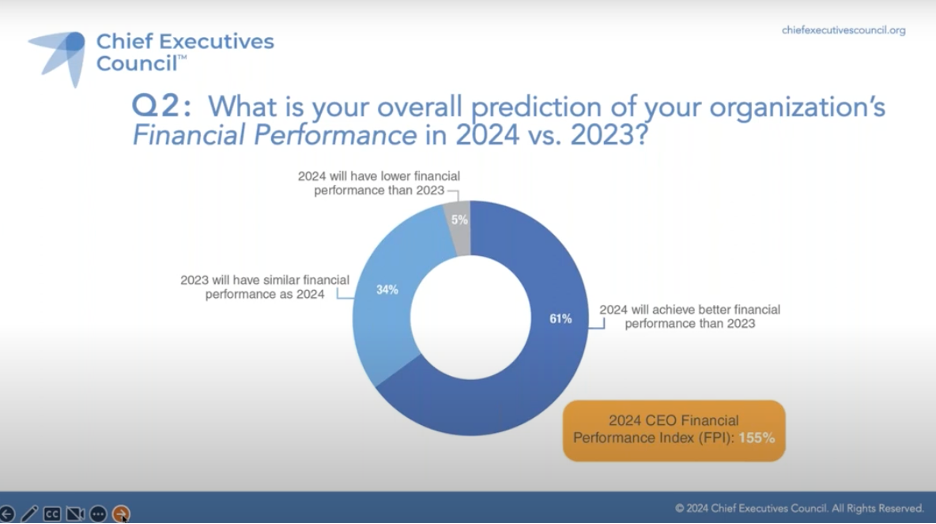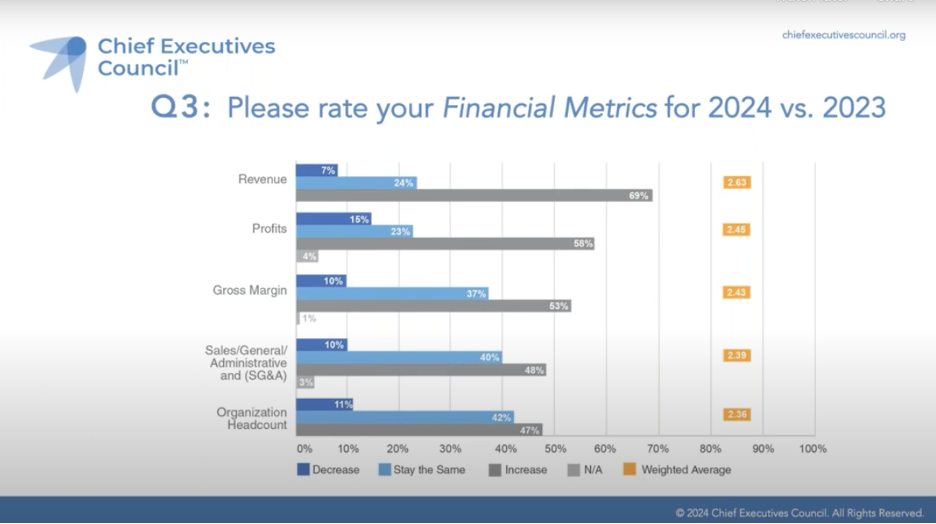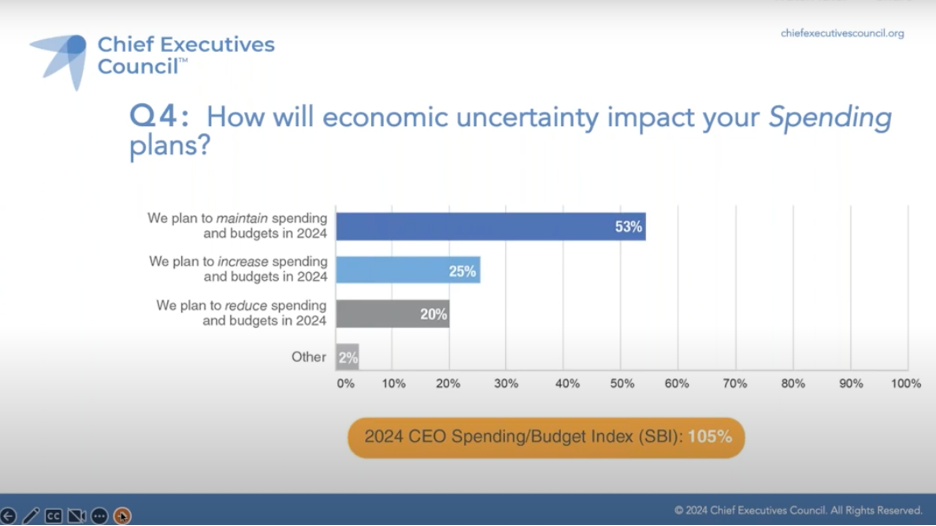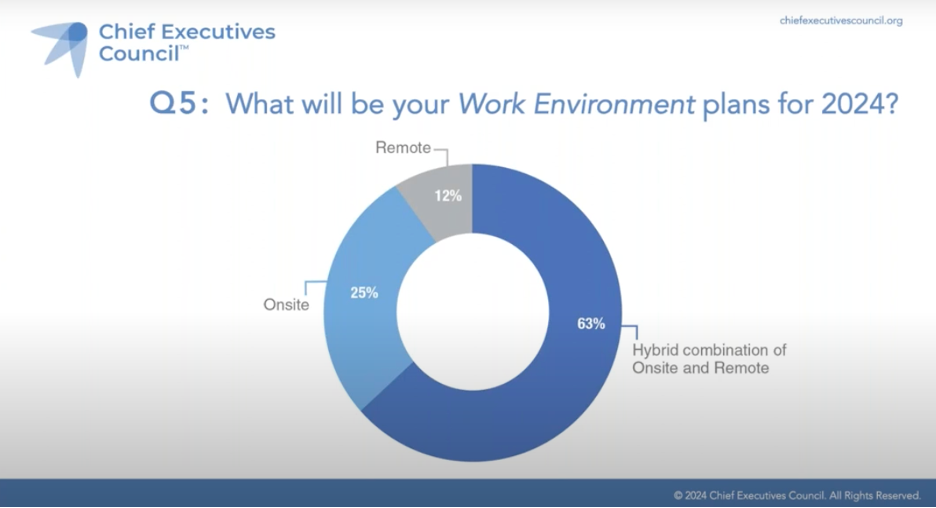Chief Executives Council recently held a webcast panel discussion on the 2024 CEO Sentiment Study Results.
Our expert panelist is Neil Brown and Jim Treleaven. Neil Brown is the CEO of the Chief Executives Council. He’s a career marketer, CMO, and CEO, and serial entrepreneur. Neil is an author of two books on marketing and earned an MBA from Northern Illinois University. Jim Treleaven is CEO of Via Strategy Group, a professor of data analytics at the University of Illinois Chicago and board director. Jim is an author and frequent speaker. He has a PhD in management information decision sciences from Case Western and an MBA from the University of Minnesota.
During this discussion, Neil and Jim discussed several key predictions for changes in financial metrics, spending, talent and more in 2024. If you are interested in learning more, view the full webinar archive video here.
Takeaway 1: Greatest concerns include talent, recession, inflation, supply chain, and geopolitical risk

Talent ranked as their biggest concern, but closely followed by recession and the financial performance. With financial performance also is the largest number of highest concerns. Inflation, interest rates, geopolitical risk and supply chain follow. What is your perspective on these concerns and rankings?
Neil: I’d separate them by external concerns and internal concerns. So, there’s only so much that you can do as an executive, as a manager, about the economy and inflation and interest rates and that kind of thing. So those are external forces that you must be aware of but maybe out of your control. What you can potentially have some control over is internal, and those would be things like talent and of course financial performance.
Jim: When I talk about the economy, it’s far from homogeneous. So, for example, the risk of recession is possible in some industries and not in others. So, you need to be very aware of what the macro economy is potentially doing in your sector. And the overall forecast for recession, which has changed a lot in the last 12 months or so, has some effect, but it’s very important for a CEO to pay and senior management to pay attention to how that might be affecting your sector. So, for example, we see that electric vehicles are having a downturn for a variety of reasons. And so that’s something that they need to be aware of. Same thing with interest rates and inflation. If you’re in the financial sector, interest rates have a much bigger impact than if you are not. And inflation has a bigger impact if you’re in retail. So, it’s important to look at all these sorts of macroeconomic indicators relative to your particular sector. And then try to anticipate those and manage accordingly. Talent is an important one. And since I have lots of students who are actively looking for jobs… It’s interesting that a year ago when I took a poll, they all had jobs, mostly all grad students. So, they had jobs when they were going to graduate and that’s not true this year. So there seems to be a surplus of talent in the marketplace relative to what the demand is. And obviously the students I have are graduate business school students. But talent is always a challenge for companies and something they need to pay a lot of attention to.
Takeaway 2: 2024 CEO Financial Performance witnessed a “bullish” 155% index with 61% increasing and only 6% decreasing

What is your overall prediction of your organization’s financial performance this year versus 2023? The answer came back is 61% better or increased financial performance, 34% same, and only6 % decreased in 2024 versus 2023. That seems to be good news. The CEO Financial Performance Index (FPI), is calculated as the increase minus the decrease plus the 100 base. So that’s how we get the 155%. Compared to our sister council, the Controllers Council tallied a FPI of 139%.
Jim: I would say if the CEO index was lower than the controllers and financial executives, I would be shocked if that was ever true. Bravo. I would hope that the CEOs would always have a more optimistic outlook than the financial people. I’m not surprised at 2024 because there was a lot of uncertainty around 2023. And that’s still true. But in terms of the CEOs looking forward, I think that in addition to the sort of natural tendency to be optimistic, I think that most of the indicators, and again, that’s going to vary by industry. Most of the indicators are for a little bit more stability, although I can name a million things that could make things less stable. But again, I’m not surprised, and I think that’s a positive thing.
Takeaway 3: Financial Metrics increases predicted for revenue by 61%, profits by 46%, GM by 45%; with cost increases for SG&A by 48%, and head count by 46%

Neil: Revenue doesn’t surprise me that that’s a number one highest percentage and number one weighted average because I feel that as a leader you can forecast revenue, but I really think profit and gross margin and costs are just really difficult to be accurate on even though the experts are saying that inflation has been tamed. Because year over year, just last month, is lower. But the fact is we had this record inflation only a year ago and those prices that inflation has not receded. Inflation doesn’t go back.
Jim: I would agree, except that if we put a standard deviation on all of them, I think the revenue would have the largest, simply because, you know, can I forecast what my costs are going to be reasonably accurately, even in the face of inflation? And revenue, you know, depending on the business again, it’s going to vary a lot, but revenue generally is, has the sort of highest variance of all those factors. And then it drives profits for sure. So, all of it sort of falls out of the revenue forecast.
Takeaway 4: Reduced budgets are anticipated by 36%, with only 20% increasing for spending/budget index of 105%

Jim: I’m not surprised that they plan to maintain it. I mean, I think anything else in the current environment is risky. I’m not surprised that increase came in second. I am surprised that 20 % thought they would reduce it. I would have guessed that would have been much smaller. But I think given the level of uncertainty, maintaining spending makes the most sense. That’s going to be adjusted during the year. You come up with a budget and things happen and you adjust it as the year progresses. But yeah, I’m not surprised given the level of uncertainty that, and again, it’s going to vary by sector, but given the level of uncertainty that maintenance, maintaining came out number one. And again, I’m not at all surprised it’s more optimistic than the controllers.
Neil: I totally agree with that. But if you’re forecasting increased financial metrics, then increased spend should go along with that, you would think. You got to spend money to make money, that kind of thing.
Takeaway 5: A majority 63% of organizations are planning a hybrid combination of onsite and remote work environment

Lindy: I can speak for myself as a partner at Armanino. We have about 275 partners and going on 3,000 team members overall. That obviously during COVID, we were, everybody was working from home, and we were just going on cameras. And that’s actually when the Controllers Council was first founded and subsequently, we have developed other community platforms. But, you know, we are in the combination of the hybrid. We’re expecting our staff to be on site two to three days a week. We got new work scheduling software so they can schedule their desk and know when they’re going to be in and get a workplace. Some of the ones that are more frequent can actually get assigned a desk instead of having to schedule it two weeks out. Then, we’re trying to do things at Armanino to make going into the office more exciting, such as happy hour, scavenger hunt coming up in our Chicago office, theme days, etc.
Jim: We were remote when the temperature went below, 15 below. But otherwise, yes, we are on site. In that environment, I think that’s very important. Obviously, we have Zoom, and we did that that day. But like at Armanino, we used to always call it OJT, on the job training. And you had to sit there with your mentors and your people above you and learn and watch them and talk the talk and talk to the clients, go on site, meet the people. And that’s how we learned back in the day. I would agree completely. And as I see what’s going on in the marketplace, I’m not surprised that hybrid is the highest level.
To view the complete webcast panel discussion, click here.
To download/read/print the 2024 CEO Sentiment Study Results Report, click here.


0 Comments